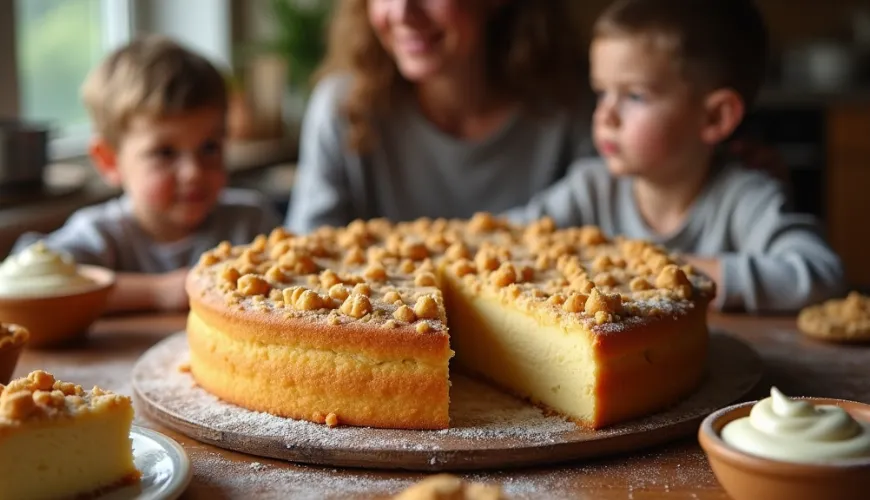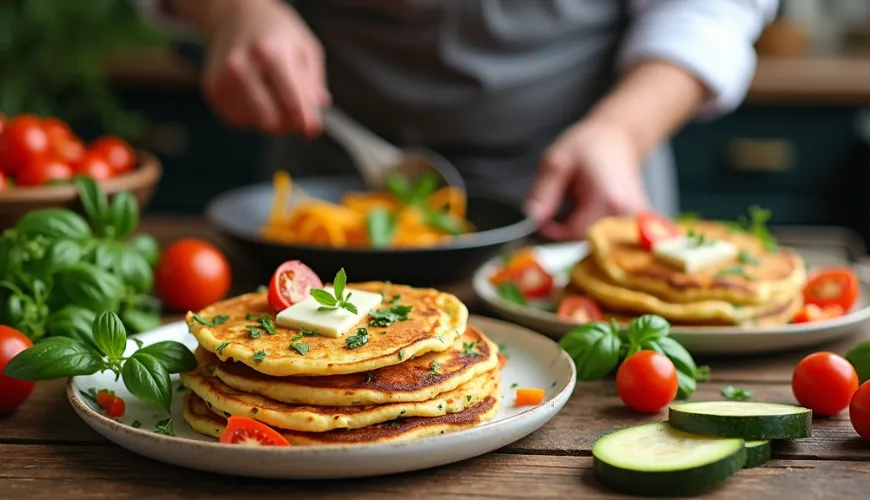
How to Make Authentic Prague Cake According to Our Grandmothers

The Prague Cake and Its Return to Czech Kitchens
Just look at a photo from a family celebration or a wedding table from the 1980s, and there it is. Unassuming, perhaps a bit forgotten, but always certain – the Prague Cake. Often placed next to cream puffs and meringues, it was a symbol of homemade confectionery that carried honesty, simplicity, and a taste that one remembers. Today, this traditional dessert is making a comeback – with nostalgia, but also with a modern approach. And it's no wonder. The combination of soft leavened dough, delicate pudding cream, and buttery crumble creates something deserving of the title “the best Prague Cake."
What Exactly is the Prague Cake?
The Prague Cake is not just another sweet pastry. It is one of those recipes passed down through generations – from grandmother to mother, from mother to daughter. Yet many people still struggle to precisely describe what it actually comprises. Essentially, it is a leavened cake filled with vanilla pudding cream, topped with buttery crumble, and sometimes lightly dusted with sugar after baking. It’s not a bundt cake, it’s not a strudel – and that makes it unique.
It is the pudding cream that distinguishes it from classic Moravian cakes with jam or cheese. It gives the cake moisture and softness, creating an unmistakable taste in combination with the buttery dough. And although it may seem modest, when done right, it transforms into a dessert worthy of a festive table.
The Original Prague Cake
Authenticity is a frequently mentioned word today, but in the case of traditional recipes, it is well justified. If you are considering how to prepare the Prague Cake according to the original recipe, you need to adhere to several principles. Similar to other historical dishes, there are slight regional or family variations, but the base is more or less unchanged:
- The dough must be leavened, soft, and buttery.
- The filling consists of vanilla pudding, ideally not from a packet, but homemade using milk, egg yolks, starch, and real vanilla.
- The crumble is classic – made from butter, flour, and sugar.
- Baking is done in a large round form, and the cake is sliced like a pie after cooling.
Some modern versions add the flavor of lemon zest in the cream or a pinch of nutmeg in the dough, but these adjustments should not come at the expense of the original taste's delicate harmony.
One recollector, Mrs. Marie from Benešov, recalls: "My mother baked the Prague Cake every Sunday. She started the dough in the morning, and by the time we came back from church, it had beautifully risen. She made the cream from homemade milk and eggs, and the cake often lasted only until Monday."
How to Bake the Best Prague Cake at Home
Although it may seem complex, the recipe for the Prague Cake with pudding cream is manageable even for beginner bakers with a bit of patience. The key to success is quality ingredients – fresh butter, whole milk, vanilla, genuine yeast. In many households, this cake is a symbol of weekend coziness, when the whole kitchen smells, and children eagerly await until the cake is at least slightly cooled.
And what if you are not confident with leavened dough? There’s a solution for that too. Many people today experiment with simpler doughs – perhaps with quark or yogurt – but the result will never be as rich and airy as with the classic.
Here is a brief guide on how to prepare a cake that tastes just like you remember from childhood:
Ingredients:
- 500 g plain flour
- 250 ml milk
- 100 g granulated sugar
- 1 cube of yeast (42 g)
- 2 egg yolks
- 100 g melted butter
- pinch of salt
- zest of 1 lemon
For the cream:
- 500 ml milk
- 2 egg yolks
- 60 g sugar
- 1 vanilla pod or a teaspoon of real vanilla
- 40 g cornstarch
For the crumble:
- 100 g semi-coarse flour
- 70 g butter
- 70 g sugar
Let the dough rise for at least an hour, then spread it into a buttered form. Cook the cream, let it cool slightly, and spread it evenly over the dough. Finally, sprinkle with crumble and bake until golden – about 35 minutes at 180 °C.
Why is the Prague Cake Returning to Fashion?
In a time when shops are filled with endless desserts containing palm oil and flavorings, there is a growing interest in traditional, homemade recipes. People are seeking the taste they remember from childhood while also returning to quality ingredients. Moreover, the Prague Cake fits beautifully into the concept of slow baking – no rush, just the joy of creation.
Additionally, it stores well, is suitable with coffee, for breakfast, or as a treat for guests. Its elegant appearance invites creativity – some homemakers decorate it with almond slices, others add a bit of rum to the cream or a raspberry topping on top.
Social media has also played a significant role, with photos tagged #prazskykolac starting to appear. Recipes are shared, cake photos receive hundreds of likes, and the younger generation thus discovers the charm of this retro dessert.
A Little Tip to Conclude
Today, when gift baskets are full of chocolates from supermarkets and flowers often lack fragrance, a homemade Prague Cake can be an original and personal gift. Wrap it in baking paper, tie it with a rustic ribbon, and add a note with the recipe. Not only will you bring joy, but you might also inspire another person to remember what a genuine home tastes like.
Perhaps that is why so many people today are asking how to bake the “original Prague Cake." The answer is simple: with love, patience, and respect for what has long been before us.

